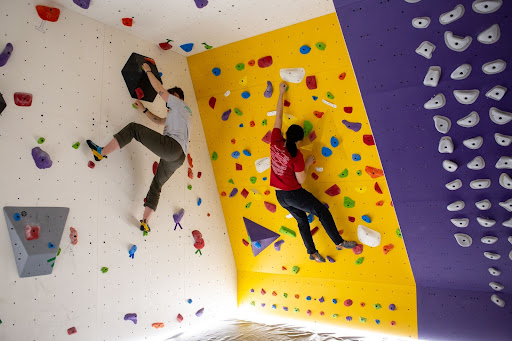WOC cuts ribbon for new bouldering barn
April 12, 2023

“I’m not much of a climber, but I’m really excited to see the students use it,” President Maud S. Mandel said last Wednesday at the grand opening of the Bouldering Barn inside the Pond House garage, as students made their first attempts at sending — or reaching the top, in climber-speak — the new climbing routes. The newly constructed space will be open six days a week, and it is large enough to host 10 climbers at a time.
Muzhou Lu ’13 first had the idea to create a bouldering space in 2012, which he envisioned inside what was formerly Greylock Dining Hall. Since then, the project has had to overcome significant hurdles — including a pandemic and supply chain delays — before finally coming to fruition last week.
At the ribbon-cutting event, Williams Outing Club (WOC) Director Scott Lewis thanked a few community members for their contributions, including Felix Grossman ’56, who financially supported the project and to whom the space is dedicated, as well as Facilities Project ManagerJulie Sniezek and Director of Athletics Lisa Melendy.
Lewis, however, offered his highest praise to the students who guided the project to completion throughout the past year, including Abby Kinney ’24, Isabel Albores ’23, Thomasina Hare ’25, and Jonah Tobin ’23. These students worked with Assistant Outing Club Director Dave Ackerson, who was particularly suited to help students design the space, as he’s been climbing and working in climbing gyms for the past 30 years, Lewis said.
“It took a Williams College village to build this thing,” Lewis added.
Isabel Albores ’23, who is a part of the WOC board, the Williams Climbing Club (WCC), and the design team for the project, said she thought the Bouldering Barn will improve the College’s climbing community. “It’s a great space for people to start climbing and learn because there’s a very low entry barrier,” she said.
WCC plans regular off-campus trips to offer students access to climbing walls, but Albores said the Boulding Barn will eliminate some of the need for those.
Ben Connor ’25, who is part of WOC board and WCC, also noted that the new space will provide on-campus climbing access to students after the College indefinitely closed Towne Field House — the home of the College’s only climbing wall — for maintenance last month. “[It] represents a lot more now that the Field House is not operational,” he said. “The fact that we have anywhere to climb at all is really nice.”
Even once the Field House opens, Connor added, the opening of the Bouldering Barn will mean that there will be more hours available for students to climb, as new space is open for four more three-hour slots every week. “Having all these walls makes a big difference in terms of the things we can do and the things we can also offer to people during opening hours,” Connor said. The barn also provides a space dedicated exclusively to climbing, while the climbers shared the Field House with other sports teams such as track and baseball.
The design team’s main challenge was getting all the necessary materials to build the barn. The team had to be patient, Albores said, particularly when the barn didn’t have any flooring for months this past winter.
When imagining the space, the design team pushed for what is now the barn’s main attraction: the Kilter Board. This overhang wall lights up different patterns of holds so that climbers can try an inexhaustible number of climbs on a small section of wall. Users can share the Kilter Board climbs that they create online, said Henry Wieman ’25, a member of WCC who also worked at the climbing wall before the Field House closure. This allows students at the College to recreate these climbs in the barn with the Kilter Board’s lighting system.
Wieman said that WCC has been anticipating the opening of the Bouldering Barn since October, and that the space will “definitely have a positive impact on the climbing community.”








